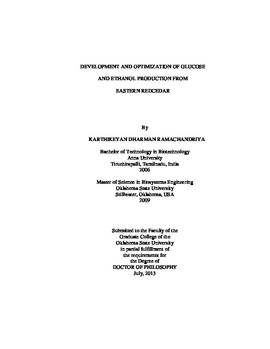| dc.contributor.advisor | Wilkins, Mark R. | |
| dc.contributor.author | Ramachandriya, Karthikeyan Dharman | |
| dc.date.accessioned | 2014-09-24T14:17:03Z | |
| dc.date.available | 2014-09-24T14:17:03Z | |
| dc.date.issued | 2013-07 | |
| dc.identifier.uri | https://hdl.handle.net/11244/11036 | |
| dc.description.abstract | The overall objective of this project was to develop and optimize a process to efficiently extract glucose from cellulose in Eastern redcedar and to demonstrate ethanol production at high efficiencies and titers. To accomplish this goal, the first step was to develop a pretreatment process for efficiently extracting sugars from redcedar wood. A statistical approach was taken for determining the vital few factors affecting redcedar pretreatments. Subsequently, the optimum conditions for achieving maximum overall wood glucan-to-glucose yield (% of theoretical) was determined using response surface methodology. A functional model relating four important pretreatment parameters (pretreatment temperature, hold time, sulfuric acid and sodium bisulfite loading) and wood glucan-to-glucose yield was obtained. The model was validated achieving 87% of theoretical wood glucan-to-glucose yield. Then, the operability of pretreated redcedar at high solids (substrate) loading was tested. Rheological challenges observed at high solids loading were overcome by adding stainless steel balls to shake flask reactors. The highest glucose concentration, 126 g L-1, was obtained using 20% solids loading in the presence of stainless steel balls as a mixing aid, which was subsequently fermented by S. cerevisiae D5A to produce 52 g L-1 of ethanol. Such a concentrated stream of products would reduce the capital and operating costs of a commercial process. Afterwards, the effects of two wood zones (sapwood versus heartwood) and two particle sizes (2.5 mm versus 0.5 mm) on wood glucan-to-ethanol yield were investigated. Results demonstrated that particle size had no effect on wood glucan-to-ethanol yield, which was a significant finding because energy costs during milling operations could be reduced. Additionally, it was observed that ethanol yields were 13% lower with heartwood than with sapwood. Finally, the effect of redcedar oil on ethanol fermentations by yeast and enzymatic hydrolysis of pure cellulose was determined. The presence of redcedar oil at 1% (w/w) inhibited enzymatic hydrolysis of cellulose to glucose by 33%, but had only a marginal inhibitory effect on ethanol fermentations during the first 9 h of fermentation. Therefore, it is recommended to remove redcedar oil from the raw material prior to hydrolysis of redcedar by cellulase. | |
| dc.format | application/pdf | |
| dc.language | en_US | |
| dc.rights | Copyright is held by the author who has granted the Oklahoma State University Library the non-exclusive right to share this material in its institutional repository. Contact Digital Library Services at lib-dls@okstate.edu or 405-744-9161 for the permission policy on the use, reproduction or distribution of this material. | |
| dc.title | Development and optimization of glucose and ethanol production from Eastern redcedar | |
| dc.contributor.committeeMember | Atiyeh, Hasan K. | |
| dc.contributor.committeeMember | Dunford, Nurhan T. | |
| dc.contributor.committeeMember | Hiziroglu, Salim | |
| osu.filename | RamachandriyaDharman_okstate_0664D_12939.pdf | |
| osu.accesstype | Open Access | |
| dc.type.genre | Dissertation | |
| dc.type.material | Text | |
| thesis.degree.discipline | Biosystems Engineering | |
| thesis.degree.grantor | Oklahoma State University | |
